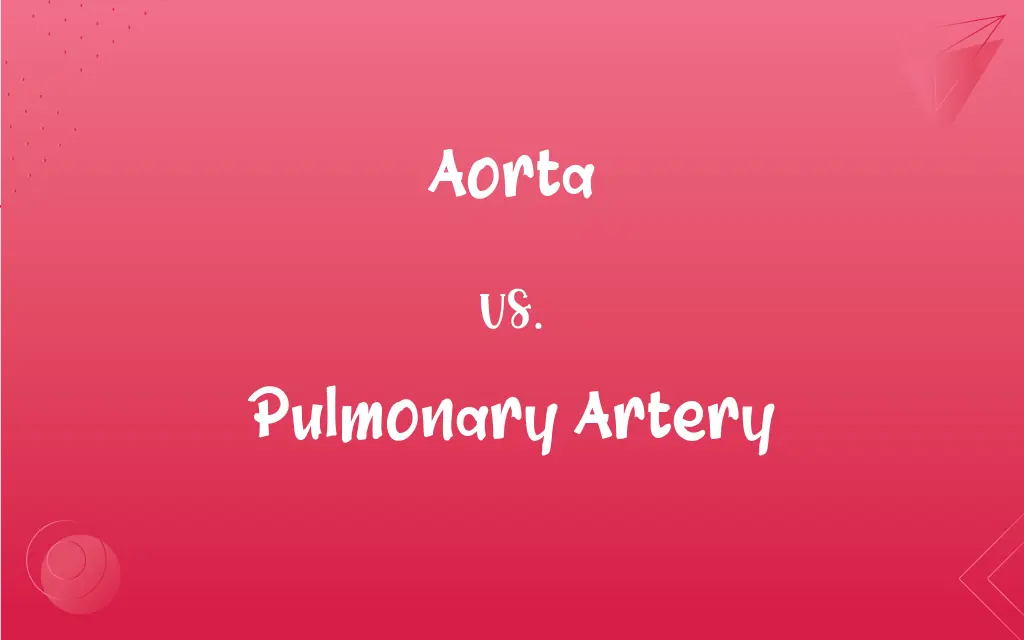Aorta vs. Pulmonary Artery: What's the Difference?
Edited by Aimie Carlson || By Harlon Moss || Updated on October 13, 2023
The aorta carries oxygen-rich blood from the heart to the body, while the pulmonary artery transports oxygen-poor blood from the heart to the lungs for oxygenation.

Key Differences
The aorta and the pulmonary artery serve pivotal roles in circulatory physiology, diverging in their destinations and the oxygen content of the blood they carry. Aorta distributes oxygenated blood from the left ventricle to the systemic circulation, while the pulmonary artery conveys deoxygenated blood from the right ventricle to the lungs.
One distinct structural difference between the aorta and the pulmonary artery pertains to their relative positioning and dimensions. The aorta, remarkably thick and robust, emanates from the left ventricle, while the pulmonary artery originates from the right ventricle, being comparatively shorter and wider.
Engaging the contrast of their functional implications, the aorta is instrumental in ensuring that all body tissues receive the oxygen and nutrients they necessitate. In contrast, the pulmonary artery fulfills a critical role in transporting blood needing oxygenation to the lungs, facilitating gas exchange.
Pathological considerations reveal diverse challenges for the aorta and pulmonary artery, given their individual responsibilities. Aortic dissections or aneurysms may perilously interrupt systemic circulation, while pulmonary artery hypertension can impose detrimental strains on the right side of the heart.
Recognizing the surgical and interventional contexts, procedures involving the aorta and pulmonary artery are executed with meticulous precision due to their vital roles. Aortic surgeries often entail intricate interventions due to its high-pressure nature, while pulmonary artery procedures necessitate strategic approaches to manage pulmonary circulatory dynamics.
ADVERTISEMENT
Comparison Chart
Blood Oxygen Level
Carries oxygen-rich blood.
Carries oxygen-poor blood.
Originating Chamber
Emerges from the left ventricle.
Emerges from the right ventricle.
Destination
Distributes blood to the systemic circulation.
Transports blood to the lungs.
Associated Conditions
Aneurysms, dissections, and coarctation.
Pulmonary hypertension, embolism.
Surgical Considerations
Often involves high-pressure, systemic interventions.
Focuses on pulmonary circulatory dynamics.
ADVERTISEMENT
Aorta and Pulmonary Artery Definitions
Aorta
The aorta is the largest artery in the body, originating from the left ventricle of the heart.
The aorta distributes blood to all the arterial systems within the body.
Pulmonary Artery
The pulmonary artery plays a crucial role in the pulmonary circulatory system.
The pulmonary artery ensures blood is circulated to the lungs to receive oxygen.
Aorta
The aorta is susceptible to conditions such as aneurysms and dissections.
Aneurysms in the aorta can be life-threatening if they rupture.
Pulmonary Artery
The pulmonary artery can be affected by conditions such as pulmonary hypertension.
Pulmonary hypertension involves elevated pressure within the pulmonary artery.
Aorta
The aorta is characterized by its thick, muscular wall, enabling it to withstand high pressure.
The aorta’s muscular wall propels blood throughout the body.
Pulmonary Artery
The pulmonary artery conveys oxygen-depleted blood from the heart to the lungs.
Blood flows into the pulmonary artery after passing through the right ventricle.
Aorta
The aorta traverses the thoracic and abdominal regions of the body.
The abdominal aorta bifurcates into the common iliac arteries.
Pulmonary Artery
The pulmonary artery is unique in carrying deoxygenated blood, diverging from typical arterial function.
Unlike other arteries, the pulmonary artery transports blood low in oxygen.
Aorta
The aorta is the main artery that carries oxygen-rich blood from the heart to the body.
The surgeon repaired the damaged section of the aorta.
Pulmonary Artery
The pulmonary artery bifurcates into two, supplying both lungs with blood.
The pulmonary artery divides to send blood to each lung for oxygenation.
Aorta
The main trunk of the systemic arteries, carrying blood from the left side of the heart to the arteries of all limbs and organs except the lungs.
Aorta
(anatomy) The great artery which carries the blood from the heart to all parts of the body except the lungs; the main trunk of the arterial system.
Aorta
(figuratively) The liveliest part of something.
Aorta
The great artery which carries the blood from the heart to all parts of the body except the lungs; the main trunk of the arterial system.
Aorta
The large trunk artery that carries blood from the left ventricle of the heart to branch arteries
FAQs
What is the aorta?
The aorta is the largest artery in the body, originating from the left ventricle of the heart and extending down to the abdomen.
What is the function of the aorta?
It carries oxygenated blood from the heart to the rest of the body.
How do you spell “aorta”?
A-O-R-T-A
Are there related words to "aorta"?
Yes, related words include arterial, arteriole, and cardiovascular.
How is "aorta" pronounced?
Aorta is pronounced as [ay-OR-tuh].
How is “aorta” used in a sentence?
"The surgeon repaired the damaged section of the aorta."
What is the pulmonary artery?
The pulmonary artery carries deoxygenated blood from the right ventricle of the heart to the lungs.
How is “pulmonary artery” pronounced?
It is pronounced as [PUL-muh-nair-ee AHR-tuh-ree].
What is the function of the pulmonary artery?
Its function is to transport blood from the heart to the lungs for oxygenation.
Are there disorders related to the pulmonary artery?
Yes, such as pulmonary hypertension, which is high blood pressure in the arteries supplying the lungs.
How can “pulmonary artery” be used in a sentence?
"The blood flows from the right ventricle into the pulmonary artery."
Can “aorta” be used metaphorically?
Yes, it's occasionally used metaphorically to describe a principal artery or conduit.
Is “pulmonary” specific to the lungs?
Yes, “pulmonary” relates specifically to the lungs.
Is "aorta" a noun or a verb?
"Aorta" is a noun.
Can “aorta” be plural?
Rarely, but yes. The plural form is “aortas”.
How do you spell “pulmonary artery”?
P-U-L-M-O-N-A-R-Y A-R-T-E-R-Y
Can "pulmonary artery" be abbreviated?
Yes, it is sometimes abbreviated as "PA".
What is the significance of the pulmonary artery in the circulatory system?
It’s vital for the oxygenation of blood, carrying deoxygenated blood to the lungs where it receives oxygen.
What is the etymology of "aorta"?
"Aorta" originates from the Greek "aortē", meaning the great artery.
Can the term “pulmonary artery” be used metaphorically?
It is not commonly used metaphorically due to its specific anatomical reference.
About Author
Written by
Harlon MossHarlon is a seasoned quality moderator and accomplished content writer for Difference Wiki. An alumnus of the prestigious University of California, he earned his degree in Computer Science. Leveraging his academic background, Harlon brings a meticulous and informed perspective to his work, ensuring content accuracy and excellence.
Edited by
Aimie CarlsonAimie Carlson, holding a master's degree in English literature, is a fervent English language enthusiast. She lends her writing talents to Difference Wiki, a prominent website that specializes in comparisons, offering readers insightful analyses that both captivate and inform.
































































